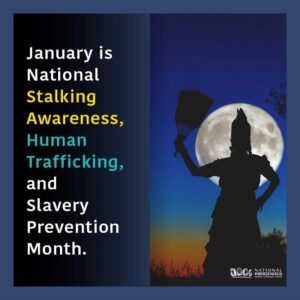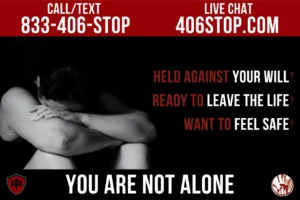by Lea Wetzel, Family Peer Supporter
January 9, 2024
CW: Sexual Assault, Trafficking
Understanding the complexity of abuse, coercion, and control can be a complex multidimensional description. When asked,” What to look for?” within human trafficking is a hard question to answer, because human trafficking isn’t one situation to describe, it can have many faces. Human Trafficking effects all social groupings, genders, and does not discriminate when it comes to its victims. There are statistics that prove the American Indian population is in fact at a higher risk of being affected by human trafficking, murder, and becoming a missing persons case. 48.8% of Native American women have been stalked in their lifetime, and 40% of sex trafficking survivors are in fact, Native American women.
Looking at missing murdered Indigenous people within the MMIP realm, we learn that our American Indian population is the most underserved population. Native women have an 84.3% rate of experiencing domestic violence, that is three out of four Indigenous women. Murder is the 3rd leading cause of death within Indigenous population.
When I first heard these statistics, I thought to myself,” Why?” Since being in the movement of Survivor-led advocacy and sharing my own lived experiences in spaces to fight for safety and security of my people, I have hear lots of different perspectives. Then one that has really stuck in my mind is the majority of American Indian’s have “O’ negative blood type, which is the Universal blood type. Thinking of the realties we know, that trafficked individuals are looked at as merchandise, and are only effective in the sex trafficking realm for so long.
This knowledge I have learned is disturbing to me.
Individuals engaged in prostitution may be in an intimate relationship and have children with their pimp/trafficker, who may have threatened to use physical violence or may have already used physical abuse, often as a mechanism to control and coerce a victim and to enforce silence when the victim encounters the justice system. Emotional abuse may be just as damaging or worse to a Survivor.
For example, threatening to “out” an LBGTQ individual to their community or family may mean the loss of social and economic support. Further, a pimp/trafficker who threatens or discloses a person’s engagement in prostitution may put that person at risk of losing their children or exacerbate emotional and economic instability, while continuing to tighten their power and control over that individual’s life.
Whether an individual is sexually assaulted by a pimp/trafficker or is forced to engage in sex work, in which case they may experience multiple sexual assaults by johns.
These experiences are difficult to talk about, or even more difficult to process the situations, because of the “molding” and “gaslighting” happening within these situations.
Consider the sex trafficking victim who is forced by her pimp to have sex with his friends or gang members. Feelings of shame and stigma are common.
Sexual assault cases are often compounded for those who are engaged in sex work and fear moral condemnation by the justice system or society at large. Feelings of intimidation and isolation are typical for victims of domestic violence and sexual assault Survivors and can complicate cases of sex trafficking. In abusive relationships, offenders often use isolation to increase power and control over the victim. Such isolation, when paired with the difficulty of disclosing abuse by an intimate partner (due to minimizing, guilt, and other possible reactions), can make the prospect of leaving the abuser seem daunting or impossible.
Obstacles to using system resources for those encountering potential victims of trafficking through the justice system, the dynamics of force and coercion may affect victims’ ability to use system resources. As in cases of domestic violence or sexual assault, the fact that Center for Court Innovation, an individual was coerced does not necessarily lessen the real or perceived blaming and stigma associated with trafficking.
 This, in turn, makes victims even more vulnerable to further trauma and less likely to seek help, especially from justice system stakeholders whom they do not know nor trust.
This, in turn, makes victims even more vulnerable to further trauma and less likely to seek help, especially from justice system stakeholders whom they do not know nor trust.
Here are some definitions and key elements within Human Trafficking recorded by the United States Department of State, Office to Monitor and Combat Trafficking in Persons:
Forced Labor, sometimes also referred to as labor trafficking, encompasses the range of activities involved when a person uses force, fraud, or coercion to exploit the labor or services of another person.
The “acts” element of forced labor is met when the trafficker recruits, harbors, transports, provides, or obtains a person for labor or services.
The “means” element of forced labor includes a trafficker’s use of force, fraud, or coercion. The coercive scheme can include threats of force, debt manipulation, withholding of pay, confiscation of identity documents, psychological coercion, reputational harm, manipulation of the use of addictive substances, threats to other people, or other forms of coercion.
The “purpose” element focuses on the perpetrator’s goal to exploit a person’s labor or services. There is no limit on the location or type of industry. Traffickers can commit this crime in any sector or setting, whether legal or illicit, including but not limited to agricultural fields, factories, restaurants, hotels, massage parlors, retail stores, fishing vessels, mines, private homes, or drug trafficking operations.
All three elements are essential to constitute the crime of forced labor.
There are certain types of forced labor that are frequently distinguished for emphasis or because they are widespread:
“Domestic servitude” is a form of forced labor in which the trafficker requires a victim to perform work in a private residence. Such circumstances create unique vulnerabilities. Domestic workers are often isolated and may work alone in a house. Their employer often controls their access to food, transportation, and housing. What happens in a private residence is hidden from the world – including from law enforcement and labor inspectors – resulting in barriers to victim identification. Foreign domestic workers are particularly vulnerable to abuse due to language and cultural barriers, as well as a lack of community ties. Some perpetrators use these types of conditions as part of their coercive schemes to compel the labor of domestic workers with little risk of detection.
The term “forced child labor” describes forced labor schemes in which traffickers compel children to work. Traffickers often target children because they are more vulnerable. Although some children may legally engage in certain forms of work, forcing or coercing children to work remains illegal. Forms of slavery or slavery-like practices – including the sale of children, forced or compulsory child labor, and debt bondage and serfdom of children – continue to exist, despite legal prohibitions and widespread condemnation. Some indicators of forced labor of a child include situations in which the child appears to be in the custody of a non-family member and the child’s work financially benefits someone outside the child’s family; or the denial of food, rest, or schooling to a child who is working.
Sex trafficking encompasses the range of activities involved when a trafficker uses force, fraud, or coercion to compel another person to engage in a commercial sex act or causes a child to engage in a commercial sex act.
The crime of sex trafficking is also understood through the “acts,” “means,” and “purpose” framework. All three elements are required to establish a sex trafficking crime (except in the case of child sex trafficking where the means are irrelevant).
The “acts” element of sex trafficking is met when a trafficker recruits, harbors, transports, provides, obtains, patronizes, or solicits another person to engage in commercial sex.
The “means” element of sex trafficking occurs when a trafficker uses force, fraud, or coercion. Coercion in the case of sex trafficking includes the broad array of means included in the forced labor definition. These can include threats of serious harm, psychological harm, reputational harm, threats to others, and debt manipulation.
The “purpose” element is a commercial sex act. Sex trafficking can take place in private homes, massage parlors, hotels, or brothels, among other locations, as well as on the internet.
In cases where an individual engages in any of the specified “acts” with a child (under the age of 18), the means element is irrelevant regardless of whether evidence of force, fraud, or coercion exists. The use of children in commercial sex is prohibited by law in the United States and most countries around the world.
These key principles and concepts relate to all forms of trafficking in persons, including forced labor and sex trafficking.
Human trafficking can take place even if the victim initially consented to providing labor, services, or commercial sex acts. The analysis is primarily focused on the trafficker’s conduct and not that of the victim. A trafficker can target a victim after a victim applies for a job or migrates to earn a living. The trafficker’s exploitative scheme is what matters, not a victim’s prior consent or ability to meaningfully consent thereafter. Likewise, in a sex trafficking case, an adult victim’s initial willingness to engage in commercial sex acts is not relevant where a perpetrator subsequently uses force, fraud, or coercion to exploit the victim and cause them to continue engaging in the same acts. In the case of child sex trafficking, the consent of the victim is never relevant as a child cannot legally consent to commercial sex.
Neither U.S. law nor international law requires that a trafficker or victim move across a border for a human trafficking offense to take place. Trafficking in persons is a crime of exploitation and coercion, and not movement. Traffickers can use schemes that take victims hundreds of miles away from their homes or exploit them in the same neighborhoods where they were born.
“Debt bondage” is focused on human trafficking crimes in which the trafficker’s primary means of coercion is debt manipulation. U.S. law prohibits perpetrators from using debts as part of their scheme, plan, or pattern to compel a person to work or engage in commercial sex. Traffickers target some individuals with an initial debt assumed willingly as a condition of future employment, while in certain countries traffickers tell individuals they “inherited” the debt from relatives. Traffickers can also manipulate debts after the economic relationship begins by withholding earnings or forcing the victim to assume debts for expenses like food, housing, or transportation. They can also manipulate debts a victim owes to other people. When traffickers use debts to compel labor or commercial sex, they have committed a crime.
A victim-centered and trauma-informed approach is key to successful anti-trafficking efforts. A central tenet to such an approach is that victims of trafficking should not be inappropriately penalized solely for unlawful acts they committed as a direct result of being trafficked. Effective implementation of the “non-punishment principle,” as it is increasingly referred to, not only requires recognizing and embracing the principle in regional and national laws, but also increasing proactive victim identification.
While the TVPA and UN TIP Protocol call on governments to proactively address trafficking crimes, some governments are part of the problem, directly compelling their citizens into sexual slavery or forced labor schemes. From forced labor in local or national public work projects, military operations, and economically important sectors, or as part of government-funded projects or missions abroad, officials use their power to exploit their nationals. To extract this work, governments coerce by threatening the withdrawal of public benefits, withholding salaries, failing to adhere to limits on national service, manipulating the lack of legal status of stateless individuals and members of minority groups, threatening to punish family members, or conditioning services or freedom of movement on labor or sex. In 2019, Congress amended the TVPA to acknowledge that governments can also act as traffickers, referring specifically to a “government policy or pattern” of human trafficking, trafficking in government-funded programs, forced labor in government-affiliated medical services or other sectors, sexual slavery in government camps, or the employment or recruitment of child soldiers.
Another manifestation of human trafficking occurs when government forces or any non-state armed group unlawfully recruits or uses children – through force, fraud, or coercion – as soldiers or for labor or services in conflict situations. Children are also used as sex slaves. Sexual slavery, as referred to here, occurs when armed groups force or coerce children to “marry” or be raped by commanders or combatants. Both male and female children are often sexually abused or exploited by members of armed groups and suffer the same types of devastating physical and psychological consequences associated with sex trafficking.
Forced labor is well documented in the private economy, particularly in agriculture, fishing, manufacturing, construction, and domestic work; but no sector is immune. Sex trafficking occurs in several industries as well. Most well-known is the hospitality industry, but the crime also occurs in connection with extractive industries where activities are often remote and lack meaningful government presence. Governments should hold all entities, including businesses, accountable for human trafficking. In some countries, the law provides for corporate accountability in both the civil and criminal justice systems. U.S. law provides such liability for any legal person, including a business that benefits financially from its involvement in a human trafficking scheme, provided that the business knew or should have known of the scheme.
To add, in Indian Country we are looking at sex trafficking in a different light. Looking back on our history and the true history before the narrative was changed in many cases, some may see sex trafficking as modern-day colonialism. Looking at the true story of Pocahontas, we see that she was a very young girl that was kidnapped and sexually assaulted. In other words,” Sex trafficked.”
 Her birth name was Matoaka which means “Flower Between Two Streams,” and later during ceremony was transferred her mother’s name, Pocahontas. She was taken and assaulted by settlers, and had to give up her first baby, and later gave birth to her second son that was from a sexual assault. She was a strong woman warrior of her time, and the story of who she is and what happened back then, is a lot different than what Disney represented in their cartoon. She was one of many American Indians that were kidnapped, assaulted, and persecuted, for being themselves. Of course, this all was the beginning of many more realities like this one, from 1624. John Smith wrote a fabrication of the true story, that was based on an encounter he had in 1602.
Her birth name was Matoaka which means “Flower Between Two Streams,” and later during ceremony was transferred her mother’s name, Pocahontas. She was taken and assaulted by settlers, and had to give up her first baby, and later gave birth to her second son that was from a sexual assault. She was a strong woman warrior of her time, and the story of who she is and what happened back then, is a lot different than what Disney represented in their cartoon. She was one of many American Indians that were kidnapped, assaulted, and persecuted, for being themselves. Of course, this all was the beginning of many more realities like this one, from 1624. John Smith wrote a fabrication of the true story, that was based on an encounter he had in 1602.
Contemporary sex trafficking is a symptom of colonization. Advocates and tribal communities must address societal norms and attitudes. Identify and dismantle systems that support traffickers and look to traditional community values that can be used to support anti-trafficking efforts.
Human Trafficking Prevention Toolkit
Office to Monitor and Combat Trafficking in Persons
National Human Trafficking Hotline
Montana In non-emergency situations call or text 1-833-406-STOP (1-833-406-7867) OR reach and advocate via live chat at 406stop.com
House Bill 112 Strengthening Montana Law against human trafficking

